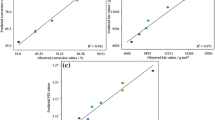Abstract
In the present work, quantitative structure–reactivity relationship (QSRR) approaches were used to predict the chain transfer constant log C x of some organic compounds as chain transfer agents in free-radical polymerization of styrene. The energy of the lowest unoccupied molecular orbital, hydrogen-bonding-dependent hydrogen donor charged area, first-order Kier and Hall index, final heat of formation/number of atoms, count of H donor sites, and Min>(0.1) bond order of a C atom were selected as the most relevant variables from the pool of calculated descriptors by the stepwise multiple regression feature selection method. Then, an artificial neural network and multiple linear regressions were utilized to construct the nonlinear and linear QSRR models. The standard errors in the prediction of log C x by the linear regression model were 0.641, 0.964, and 0.843 and by the neural network model were 0.049, 0.076, and 0.090 for training, internal, and external test sets, respectively. The predictivity of the artificial neural network model was further examined by cross-validation methods, which produce a Q 2 value of 0.85. The results of this study revealed the applicability of QSRR approaches in prediction of the chain transfer constant by using an artificial neural network.
Graphical abstract





Similar content being viewed by others
References
Moad G, Moad CL (1996) Macromolecules 29:7727
Odian G (1981) Principles of polymerization, 2nd edn. Wiley, New York
Braun D, Hempler P (1993) Polym Bull 30:55
Hemmateenejad B, Sanchooli M, Mehdipour A (2009) J Phys Org Chem 22:613
Carpenter BK (1978) Tetrahedron 34:1877
Wilcox CF, Carpenter BK, Dolbier WR (1979) Tetrahedron 35:707
Katritzky AR, Perumal S, Petrukhin R (2001) J Org Chem 66:4036
Szentpaly LV, Herndon WC (1988) Adv Chem Ser 217:287
Masunaga S, Wolfe NL, Carriera LH (1995) Environ Toxicol Chem 14:1827
Ignatz-Hoover F, Petrukhin R, Karelson M, Katritzky AR (2001) J Chem Inf Comput Sci 41:295
Maldonado AG, Doucet JP, Petitjean M, Fan BT (2006) Mol Divers 10:39
Osten DW (1988) J Chemom 2:39
Kraim K, Khatmi D, Saihi Y, Ferkous F, Brahimi M (2009) Chemom Intell Lab Syst 97:118
Nord LI, Jacobsson SP (1998) Chemom Intell Lab Syst 44:153
Luan F, Ma W, Zhang X, Zhang H, Liu M, Hu Z, Fan BT (2006) Chemosphere 63:1142
Dashtbozorgi Z, Golmohammadi H (2010) Eur J Med Chem 45:2182
Katritzky AR, Tatham DB (2001) J Chem Inf Comput Sci 41:1162
Kier LB, Hall LH (1986) Molecular connectivity in structure-activity analysis. Wiley, New York
Fatemi MH, Karimian F (2007) J Colloid Interface Sci 314:665
Li H, Ung CY, Yap CW, Xue Y, Li ZR, Chen YZ (2006) J Mol Graph Modell 25:313
HyperChem Release 7.0 for windows (2002) Hypercube, Saint-Laurent
Li Q, Chen X, Hu Z (2004) Chemom Intell Lab Syst 72:93
Stewart JPP (1989) MOPAC ver. 6.0, Quantum chemistry program exchange, QCPE, No. 455, India University
Katritsky A, Karelson M, Lobanov VS, Dennington R, Keith T (2004) CODESSA 2.7.2. Semichem, Shawnee
Katritzky AR, Lobanov VS, Karelson M (2002) Comprehensive descriptors for structural and statistical analysis, Reference Manual, Version 2.0. Semichem and University of Florida, Florida
Katritzky AR, Lobanov VS, Karelson M (1995) Chem Soc Rev 24:279
Katritzky AR, Lobanov VS, Karelson M (1997) Pure Appl Chem 69:245
Consonni V, Todeschini R (2002) Handbook of molecular descriptors. Wiley, Weinheim
Zupan J, Gasteiger J (1999) Neural networks in chemistry and drug design. Wiley, Weinheim
Bose NK, Liang P (1996) Neural network, fundamentals. McGraw-Hill, New York
Beal MT, Hagan HB, Demuth M (1996) Neural network design. PWS, Boston
Zupan J, Gasteiger J (1993) Neural networks for chemists: an introduction. VCH, Weinheim
Fatemi MH (2003) J Chromatogr A 1002:221
Fatemi MH (2002) J Chromatogr A 955:273
Jalali-Heravi M, Fatemi MH (2001) J Chromatogr A 915:177
MATLAB version 7.0 (2004) The MathWorks http://www.mathworks.com
Jalali-Heravi M, Fatemi MH (2000) Anal Chim Acta 415:95
Jalali-Heravi M, Fatemi MH (2000) J Chromatogr A 897:227
Author information
Authors and Affiliations
Corresponding author
Rights and permissions
About this article
Cite this article
Fatemi, M.H., Dorostkar, F. & Ghorbannezhad, Z. In silico prediction of free-radical chain transfer constants for some organic agents in styrene polymerization. Monatsh Chem 142, 1061–1068 (2011). https://doi.org/10.1007/s00706-011-0527-1
Received:
Accepted:
Published:
Issue Date:
DOI: https://doi.org/10.1007/s00706-011-0527-1




